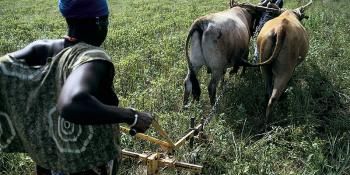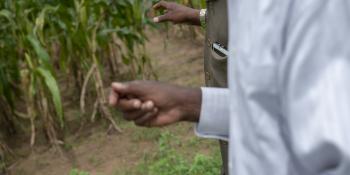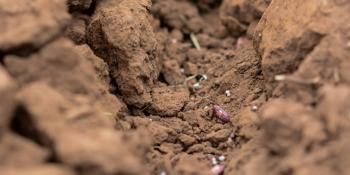What is CGIAR doing on soil carbon and climate change?

Increasing soil carbon would benefit food security and mitigate climate change, but more research is needed about how to sustainably manage the soil for carbon and other benefits.
Soil carbon – the “carbon beneath our feet” – could help mitigate significant greenhouse gas emissions, while also supporting food production and adaptation to climate change. As such, soil carbon could be crucial to meeting the Paris Agreement goal to limit global warming to below 2 degrees and Sustainable Development Goals related to food security and climate. However, we still lack the knowledge needed to sustainably manage soil for carbon. The global 4p1000 Initiative and recent activities of the Global Soil Partnership are currently rallying effort to overcome this gap.
So what is CGIAR doing on soil carbon and climate change? On June 19, 30 CGIAR scientists, representing seven CGIAR Centers and six CGIAR Research Programs (CRPs), exchanged recent research findings and identified priorities for a future research agenda on soil carbon and climate change. The meeting was hosted by the CGIAR Research Programs (CRPs) on Climate Change, Agriculture and Food Security (CCAFS), Water, Land and Ecosystems (WLE) and Forests, Trees and Agroforestry (FTA).
CGIAR’s current soil carbon and climate change work focuses on improving food security and includes:
- Improving understanding of the factors and underlying mechanisms that drive changes in soil carbon and critical soil functions.
- Examining how agronomic practices that improve soil health, agricultural productivity or socio-economic benefits affect soil carbon sequestration, greenhouse gas emissions and climate change adaptation. Practices include soil tillage, crop diversification, crop residue management, integrated soil fertility management, agroforestry, biochar, water management, pasture improvement, and use of grasses with biological nitrification inhibition traitsDetermining soil carbon mitigation potentials in different agricultural systems, including temporal and spatial patterns.
- Investigating the relationships among forests, soils, water and climate.
- Analyzing the effects of land use change on soil carbon stocks, including loss of soil carbon through deforestation and land degradation, and the potential for soil carbon sequestration through restoration of degraded soils.
- Assessing the extent of peatland soils globally and estimating current carbon stocks in peatlands.
- Supporting policy to avoid loss of carbon from peatlands, forestlands and wetlands.
- Developing standardized methods and metrics for assessing soil carbon and its dynamics, especially as an indicator of ecosystem health, at plot and landscape scales.
- Facilitating the Land Degradation Surveillance Framework Network, which now has 200 sites and 30,000 reference points in the global tropics, mostly openly accessible data.
What have we learned about how to increase soil carbon?
In the recent meeting, scientists from four CGIAR centers highlighted research from their programs:
- Conservation agriculture-based practices and soil carbon: Between myth and farmer reality. Clare Stirling (CIMMYT, CCAFS, WHEAT, MAIZE)
- Enhancing soil organic carbon (SOC) sequestration: Myth or reality in Africa? Rolf Sommer (CIAT, WLE)
- On the cricial role of SOC sequestration for soil health in landscapes: Applications for 4P1000, LDN, SDGs and land restoration. Tor-Gunnar Vågen (ICRAF, FTA)
- Soil carbon sequestration in relation to environmental footprints: A snapshot of activities at ILRI's Mazingira Centre. Lutz Merbold (ILRI, CCAFS, Livestock)
The presentations and the ensuing discussion indicated that the effects of improved technologies or practices on soil carbon sequestration are often lower than expected.
- Results from a study by CIMMYT of 125 households in southern Africa showed no evidence for soil carbon gains from conservation agriculture. Similarly, a synthesis of work in the Indo-Gangetic Plains and Sub-Saharan Africa showed only modest increases.
- Long-term trials (since 2004) of conservation agriculture and integrated soil fertility management conducted by CIAT in western Kenya showed that conservation agriculture and integrated soil fertility management increased soil organic carbon compared to conventional practices, but that soil carbon decreased over time under all practices, suggesting that it is necessary to distinguish avoided loss from sequestration gains.
- Similarly, ILRI found that soil and water conservation systems in Kenya reduced loss of soil carbon compared to conventional agriculture, but large losses still occurred with the interventions compared to the amount of soil carbon under native vegetation.
Other research presented evidence of practices that increase soil carbon, or at least minimize losses compared to business-as-usual soil management.
- In a meta-analysis of studies in sub-Saharan Africa, IITA found that combining inorganic fertilizers with organic inputs in maize production conserved about 0.5% more soil carbon over a 10-year period than inorganic fertilizers alone. The analysis showed that type of soil, climate and organic resources used significantly influenced the benefits of integrated soil fertility management practices on soil carbon sequestration and crop production.
- In Tanzania, ICRAF mapped areas and quantified the sequestration rates that would be required to meet the 4p1000 goal of increasing soil carbon globally by 4% per year to halt the annual increase of GHG emissions. ICRAF found that achieving this goal would require increased organic inputs to agricultural soils and improved rangeland management on large land areas.
- Reducing burning of crop residues in India is a promising opportunity to increase soil organic carbon, as India produces 30% of global emissions from crop residue burning. CIMMYT found significant soil carbon level increases from eliminating burning and leaving residue as mulch on the soil. Avoiding burning also enables farmers to use the residues for alternative purposes such as fodder or fuel.
Importance of soil carbon
Participants in the meeting discussed the importance of soil organic carbon as an indicator of broader ecosystem health that is responsible for multiple functions, including the capacity of soil to store and provide nutrients, control pests and diseases, hold water, reduce erosion and compaction, produce food, provide habitat, and store carbon. Currently, most assessments do not take a systems perspective to consider all the functions of soil carbon or related greenhouse gas emissions impacts in the lifecycle of a product, at the landscape level or for a whole farm. Managing carbon needs to be considered in these larger frameworks, and its impact should be translated into economic and social terms that make sense to farmers and other decision-makers. For example, communications about soil carbon should explain its potential to reduce risks due to droughts and improve productivity.
Future research priorities
Future research priorities on soil carbon and climate change identified by the group can be grouped into five general themes:
- Quantifying soil carbon sequestration potential,
- Understanding soil carbon processes,
- Evaluating the impact of land use and new technical practices,
- Methods for improved assessment, and
- Policy and action.
The scientists will take steps to support coordination of this research across CRPs in ways that make use of our extensive network of field sites and large knowledge base on sustainable agricultural practices, while also recognizing the broader ecosystem functions of soil carbon and seeking to improve understanding of the benefits and trade-offs of soil carbon sequestration. This will include developing a program of work that reflects different strategies for soil carbon management—such as (1) conserving land (including peat, wetlands, grasslands and forest), (2) rehabilitating or restoring land, or (3) sustainably intensifying agricultural land use—and the best practices with the highest potential impact under each strategy. The group will meet again later in 2017.
More reading
- App on soil organic carbon.
- Best-bet agronomic practices compendium.
- Conservation agriculture and carbon sequestration: between myth and farmer reality. Journal article.
- Does conservation agriculture deliver climate change mitigation through soil carbon sequestration in tropical agro-ecosystems? Journal article.
- Global tropical wetlands. Recent event in Jakarta.
- Importance of developing regional greenhouse gas emission factors. Presentation.
- Mazingira Centre. Website.
- Meta-analysis of soil organic carbon under integrated soil fertility management.
- FAO Global Symposium on soil organic carbon. Blog and news.
- Restoration of Degraded Lands project in East Africa and the Sahel. Project description.
- Sentinel Landscapes Explorer. Data and map.
- Sequestering soil carbon in the low input farming systems of the semi-arid tropics – does litter quality matter? Report.
- Shifting sands: putting carbon back into soils. Blog.
- Sink it or lose it: the carbon trade-off. News and blog.
- Soil carbon stocks in conservation agriculture systems of Southern Africa. Journal article.
- Soil Organic Carbon and the 4 ‰ Initiative: Soils for food security and climate. Blog.
- Soil property maps of Africa at 250 m resolution.
- Sustainable Soil Management. Event at EU Development Days in Brussels.
Follow up
Soil carbon scientists gathered again in November 2017. Read about that meeting here.
For more information please contact Lini Wollenberg at CCAFS.
Lini Wollenberg, a professor at the University of Vermont Gund Institute for Environment and affiliated with CIAT, leads low emissions development research for CCAFS.
Christopher Martius, a scientist at CIFOR, leads Climate Change Adaptation and Mitigation research for FTA.
Keith Shepherd, a scientist at ICRAF, co-leads research on Regenerating Degraded Landscapes Research for WLE.
Rolf Sommer, a scientist at CIAT, co-leads research on Regenerating Degraded Landscapes Research for WLE.



